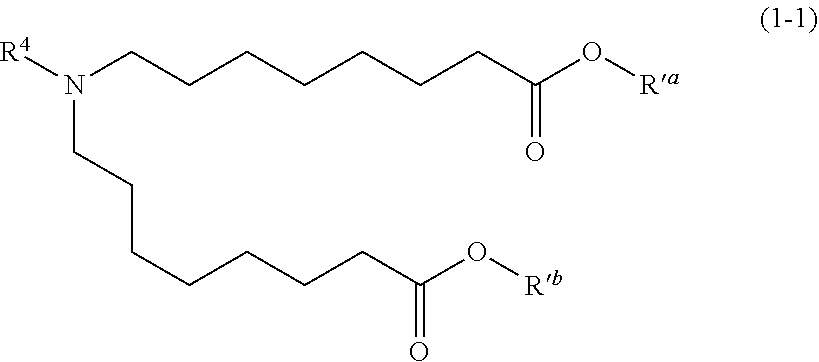Branched tail lipid compounds and compositions for intracellular delivery of therapeutic agents
- Summary
- Abstract
- Description
- Claims
- Application Information
AI Technical Summary
Benefits of technology
Problems solved by technology
Method used
Image
Examples
example 1
of Compounds of Table 1
A. General Considerations
[0545]All solvents and reagents used were obtained commercially and used as such unless noted otherwise. 1H NMR spectra were recorded in CDCl3, at 300 K using a Bruker Ultrashield 300 MHz instrument. Chemical shifts are reported as parts per million (ppm) relative to TMS (0.00) for 1H. Silica gel chromatographies were performed on ISCO CombiFlash Rf+ Lumen Instruments using ISCO RediSep Rf Gold Flash Cartridges (particle size: 20-40 microns). Reverse phase chromatographies were performed on ISCO CombiFlash Rf+ Lumen Instruments using RediSep Rf Gold C18 High Performance columns. All final compounds were determined to be greater than 85% pure via analysis by reverse phase UPLC-MS (retention times, RT, in minutes) using Waters Acquity UPLC instrument with DAD and ELSD and a ZORBAX Rapid Resolution High Definition (RRHD) SB-C18 LC column, 2.1 mm, 50 mm, 1.8 pm, and a gradient of 65 to 100% acetonitrile in water with 0.1% TFA over 5 minute...
example 2
rmulations
[0901]Lipid nanoparticles (e.g., empty LNPs or loaded LNPs) including a therapeutic and / or prophylactic can be optimized according to the selection of a compound according to Formula (1-1), (2-1), (I-a), (A), (B), (A-1), (A-2), (A-3), (IA), (IB), (B-1), (B-2), (B-3), (A-a), (A-a1), (A-a2), (A-a3), (A-b), (A-b1), (A-b2), (A-b3), (A-c), or (B-c), the selection of additional lipids, the amount of each lipid in the lipid component, and the wt:wt ratio of the lipid component to the therapeutic and / or prophylactic.
[0902]Lipid nanoparticles (e.g., empty LNPs or loaded LNPs) including DSPC as a phospholipid, cholesterol as a structural lipid, PEG-1 as a PEG lipid, and a compound according to Formula (1-1), (2-1), (I-a), (A), (B), (A-1), (A-2), (A-3), (IA), (IB), (B-1), (B-2), (B-3), (A-a), (A-a1), (A-a2), (A-a3), (A-b), (A-b1), (A-b2), (A-b3), (A-c), or (B-c) were prepared. Tables 2a and 2b summarize the characteristics of the formulations.
[0903]As shown in Tables 2a and 2b, the c...
examples 3-7
Clearance, and Tolerability of Sample Formulations
[0904]The lipids of the disclosure were developed to promote potent delivery of therapeutic agents to cells, while maintaining a short half-life (i.e., a low metabolic stability) in tissue and thus reduced lipid accumulation in the tissue upon repeat dosing. High accumulation of a lipid in a tissue could trigger toxic effects, and is thus undesirable. On the other hand, a lipid which is metabolized quickly in a tissue may not deliver enough of a therapeutic agent, such as, e.g., an mRNA, to cells to be effective. The aim of the studies outlined below is the identification of amino lipids with optimal metabolic stability which also yield high potency lipid nanoparticles (LNPs).
PUM
| Property | Measurement | Unit |
|---|---|---|
| Size | aaaaa | aaaaa |
| Size | aaaaa | aaaaa |
| Size | aaaaa | aaaaa |
Abstract
Description
Claims
Application Information
 Login to View More
Login to View More - R&D
- Intellectual Property
- Life Sciences
- Materials
- Tech Scout
- Unparalleled Data Quality
- Higher Quality Content
- 60% Fewer Hallucinations
Browse by: Latest US Patents, China's latest patents, Technical Efficacy Thesaurus, Application Domain, Technology Topic, Popular Technical Reports.
© 2025 PatSnap. All rights reserved.Legal|Privacy policy|Modern Slavery Act Transparency Statement|Sitemap|About US| Contact US: help@patsnap.com



